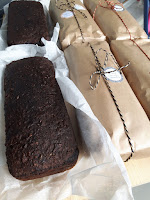Saaristolaisleipä - Finnish Archipelago bread with sourdough
What a long, strange few years it has been.
Baking feels fun again so I figured I would add a few of my most trusted recipes here to the blog in English. The first is my recipe for Finnish Archipelago bread that was a favourite for many in the Finnish sourdough baker group Hapanjuurileipurit on Facebook. The original recipe is still in the group in its 2017 form and boy have I learned a lot about this particular bread since. I have been able to streamline the recipe in many ways and it feels nice to share this recipe in its current form where all the (in hindsight pointless) fiddling has been removed from it.
.jpg) |
| Finnish Archipelago bread |
This dark malted bread is a very easy bake even for a beginner, it is a dough that is just mixed and does not require kneading. All you need is a lot of patience as depending on room temperature it takes a long time for both the dough and the bread to rise, I typically let the breads rise in the fridge overnight.
The bread has an sweet, almost chocolatey flavour to it, it's very rich and pairs beautifully with things like smoked salmon or cheese. It is usually made and eaten during the Holidays or during Midsummer festival, a common pair for it could be traditional salmon soup where the bread on the side gets eaten simply with good butter.
 |
| Archipelago bread and many traditional toppings. This is from a Christmas dinner a few years ago. |
The malt in the recipe is coarse rye malt, the Finnish product most use is a dark beer malt. Any similar product would likely work well for the recipe.
The liquid used for the bread is one that you can alter for different occasions. Many make the bread with traditional buttermilk, but personally I often just use water. For the Holidays I often like to make it with lingonberry or cranberry juice and add some frozen lingonberries to the dough. However, this slow rising bread rises best when using just plain water for the dough.
Archipelago bread:
1l (1000g) water or for example: apple juice, buttermilk or orange juice
• 300g bubbly sourdough starter (100%, wheat starter)
• 300g dark syrup
• 1tbs (15g) sea salt
• 300g coarse dark rye malt
• 110g oatmeal
• 200g rye flour
• 600g wheat flour
Glaze if using:
• 1/2dl water or juice used in dough
• 1/2dl dark syrup
Process:
Bring half of the liquid used almost to boil (if using buttermilk, heat it more sparingly so it does not split). Add your malt into the liquid and let sit for about 15-30minutes.
Add the rest of the liquid and make sure the liquid is not too hot for your sourdough starter. If it is sufficiently cool, add you starter. Otherwise wait a bit longer.
Mix in all the rest of the ingredients leaving the wheat flour last. Add the flour bit by bit until the dough is still fairly loose and will slowly fall of a ladle or a whisk. Aim for the dough to be like thick porridge. The amount of flour needed depends on how much the malt takes in water when soaking it in the beginning.
Divide the dough into baking pans (the recipe makes three 1.2l bread pans or two large ones, fill up to about 3/4) and cover. Leave the breads at room temperature for a few hours and once they start to slowly rise you can put them in the fridge overnight.
The next day heat your oven to 175°C and bake the breads in the middle rack for about one hour. Depending on how well your sourdough works and how well the breads have risen, the baking time can vary from 45 minutes up to 1,5 hours. A livelier starter makes bread that cooks faster. (It's best to see the internal temperature if unsure, I aim to over 95 Celsius even for this enriched bread.)
During the final 15 minutes of baking, you can brush the breads with the water and syrup mixture to give them a sticky and shiny finish. Personally I have stopped doing this and prefer the bread as it is without any glazing on top.
Allow to cool completely in room temperature. I like to wrap the breads when they are still warm to retain moisture.
.jpg) |
| Bread for the Holiday season |
The taste of this bread develops over a few days and when made with sourdough this bread has lasted me months in the fridge without spoiling. All the sugar and sourdough in the bread turn it into a kind of forever bread that is very handy to keep around for busier days.
I hope you enjoy this recipe, happy baking.
-Taina
Ps. This bread also makes a great gift, I have given this bread to family every Christmas for years now. I have even sent some over by post to my gaming friends in Scotland and it travelled extremely well as it lasts so well. They loved it, a lovely way to send a piece of my local cuisine over to friends in far away places.
 |
| Bread as a gift. |


Kommentit
Lähetä kommentti
Onko sinulla kysyttävää juurileivonnasta tai haluatko muuten kommentoida sisältöä tai vaikka toivoa reseptejä, sana on vapaa.